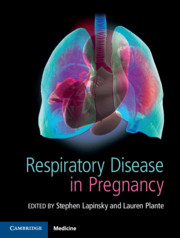Book contents
- Respiratory Disease in Pregnancy
- Respiratory Disease in Pregnancy
- Copyright page
- Contents
- Contributors
- Section 1 The Basics: for the Obstetrician
- Section 2 The Basics: for the Non-Obstetrician
- Section 3 Pulmonary Conditions Not Specific to Pregnancy
- Section 4 Pulmonary Conditions Related to Pregnancy
- Section 5 Other Pulmonary Issues in Pregnancy
- 19 Tobacco Smoking in Pregnancy
- 20 Radiological Imaging of the Chest in Pregnancy
- 21 Respiratory Drug Therapy in Pregnancy
- 22 Biological and Immunosuppressive Respiratory Therapy in Pregnancy
- 23 Oxygen Therapy during Pregnancy
- 24 Airway Management in Pregnancy
- 25 Mechanical Ventilation in Pregnancy
- Index
- References
21 - Respiratory Drug Therapy in Pregnancy
from Section 5 - Other Pulmonary Issues in Pregnancy
Published online by Cambridge University Press: 14 April 2020
- Respiratory Disease in Pregnancy
- Respiratory Disease in Pregnancy
- Copyright page
- Contents
- Contributors
- Section 1 The Basics: for the Obstetrician
- Section 2 The Basics: for the Non-Obstetrician
- Section 3 Pulmonary Conditions Not Specific to Pregnancy
- Section 4 Pulmonary Conditions Related to Pregnancy
- Section 5 Other Pulmonary Issues in Pregnancy
- 19 Tobacco Smoking in Pregnancy
- 20 Radiological Imaging of the Chest in Pregnancy
- 21 Respiratory Drug Therapy in Pregnancy
- 22 Biological and Immunosuppressive Respiratory Therapy in Pregnancy
- 23 Oxygen Therapy during Pregnancy
- 24 Airway Management in Pregnancy
- 25 Mechanical Ventilation in Pregnancy
- Index
- References
Summary
Prescribing in pregnancy and breastfeeding requires a thoughtful approach, considering maternal, fetal and neonatal physiology, and the pharmacokinetics of the prescribed drug. This chapter aims to familiarize the reader with pregnancy-related issues that should be taken into account when prescribing medications in the peri-partum period.
- Type
- Chapter
- Information
- Respiratory Disease in Pregnancy , pp. 195 - 199Publisher: Cambridge University PressPrint publication year: 2020



